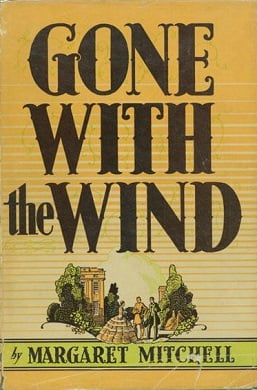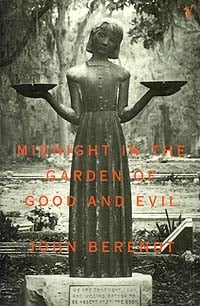The next state we're visiting on our literary journey through the United States is Georgia. This southern state is home to a rich history. It's also one of the primary inspirations for longstanding conventions of Southern belles and Southern hospitality. Georgia was home to some of the more brutal battles of the Civil War, facing much devastation in Sherman's March to the East. Modern Georgia has been rebuilt into a state rich with agriculture and tourism. It's also home to some of the most beautiful cities in the south. Whether you know Georgia for its pecans, peaches, and peanuts, for it's newfound reputation as a home of the film industry as "the Hollywood of the South," or for its historical significance, Georgia is a beautiful and fascinating state. Let's take a look at a couple of books that represent some of the many aspects of Georgia, both past and present.
Gone With the Wind by Margaret Mitchell
 It's safe to say that Gone With the Wind by Margaret Mitchell is likely the most famous and successful novel to ever take place in Georgia. The classic novel featuring beloved characters Scarlett O'Hara and Rhett Butler takes place in antebellum Atlanta and follows Scarlett through the Civil War and after as she loses everything and rebuilds her life.
It's safe to say that Gone With the Wind by Margaret Mitchell is likely the most famous and successful novel to ever take place in Georgia. The classic novel featuring beloved characters Scarlett O'Hara and Rhett Butler takes place in antebellum Atlanta and follows Scarlett through the Civil War and after as she loses everything and rebuilds her life.
It is a fascinating story of Southern Civil War-era society as well as a touching tale of survival against seemingly insurmountable odds. Gone With the Wind paints a picture of a way of life that had already died out by the time the book was published but which readers still held considerable glamour.
The book is perhaps made even more intriguing by the fact that when the story starts, we already know that Scarlett's happy life of parties and flirting won't last. The following passage shows the elegant description for which the story is known, describing the beauty of the Georgia landscape while also hinting at the horrible things to come for the characters as their lives become inevitably changed by war and emancipation:
Spring had come early that year, with warm quick rains and sudden frothing of pink peach blossoms and dogwood dappling with white stars the dark river swamp and far-off hills. Already the plowing was nearly finished, and the bloody glory of the sunset colored the fresh-cut furrows of red Georgia clay to even redder hues. The moist hungry earth, waiting upturned for the cotton seeds, showed pinkish on the sandy tops of furrows, vermilion and scarlet and maroon where shadows lay along the sides of the trenches. The whitewashed brick plantation house seemed an island set in a wild red sea, a sea of spiraling, curving, crescent billows petrified suddenly at the moment when the pink-tipped waves were breaking into surf. For here were no long, straight furrows, such as could be seen in the yellow clay fields of the flat middle Georgia country or in the lush black earth of the coastal plantations. The rolling foothill country of north Georgia was plowed in a million curves to keep the rich earth from washing down into the river bottoms.
It was a savagely red land, blood-colored after rains, brick dust in droughts, the best cotton land in the world. It was a pleasant land of white houses, peaceful plowed fields and sluggish yellow rivers, but a land of contrasts, of brightest sun glare and densest shade. The plantation clearings and miles of cotton fields smiled up to a warm sun, placid, complacent. At their edges rose the virgin forests, dark and cool even in the hottest noons, mysterious, a little sinister, the soughing pines seeming to wait with an age-old patience, to threaten with soft sighs: "Be careful! Be careful! We had you once. We can take you back again.
Midnight in the Garden of Good and Evil by John Berendt
 If Gone With the Wind shows a romanticized view of old Georgia, Midnight in the Garden of Good and Evil by John Berendt, with its gritty realism, is its complete opposite. This non-fiction book (often called a non-fiction novel for how Berendt employs fiction storytelling techniques) tells the story of a murder that took place in the '80s and exposes the underbelly of Savannah that is at odds with the charm and hospitality the city is known for. The following passage offers a humorous look at modern Georgia:
If Gone With the Wind shows a romanticized view of old Georgia, Midnight in the Garden of Good and Evil by John Berendt, with its gritty realism, is its complete opposite. This non-fiction book (often called a non-fiction novel for how Berendt employs fiction storytelling techniques) tells the story of a murder that took place in the '80s and exposes the underbelly of Savannah that is at odds with the charm and hospitality the city is known for. The following passage offers a humorous look at modern Georgia:
If you go to Atlanta, the first question people ask you is, "What's your business?" In Macon they ask, "Where do you go to church?" In Augusta they ask your grandmother's maiden name. But in Savannah the first question people ask you is "What would you like to drink?
And as a nod to the character of the state:
For me, Savannah's resistance to change was its saving grace. The city looked inward, sealed off from the noises and distractions of the world at large. It grew inward, too, and in such a way that its people flourished like hothouse plants tended by an indulgent gardener. The ordinary became extraordinary. Eccentrics thrived. Every nuance and quirk of personality achieved greater brilliance in that lush enclosure than would have been possible anywhere else in the world.
Stay tuned! Next month. we'll take a look at some of the amazing books that come from the great state of Hawaii.









